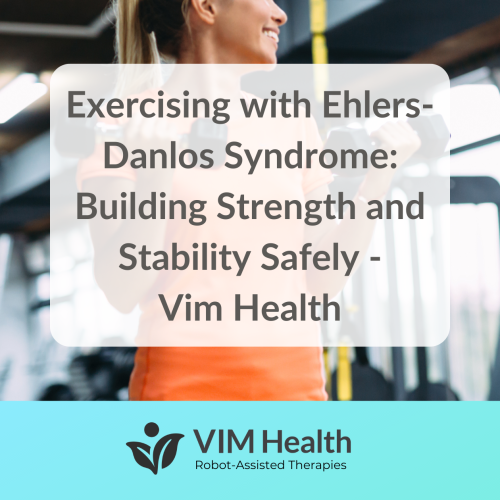Ehlers-Danlos Syndrome (EDS) is a group of genetic connective tissue disorders characterised by joint hypermobility, skin that bruises easily, and chronic pain. For many people living with EDS, the thought of exercising can be daunting. Concerns about injury, fatigue, or exacerbating symptoms often prevent individuals from engaging in physical activity. However, when approached correctly, exercise can play a vital role in managing EDS, improving joint stability, and enhancing overall quality of life.
Understanding the Role of Exercise in EDS
Connective tissue, made up of collagen, is what gives our bodies structure and support. In EDS, faulty collagen leads to weakened tissues, making joints more prone to dislocation, sprains, and other injuries. Exercise, particularly when focused on low-impact and strengthening activities, helps build the muscles around joints, providing much-needed support and reducing the risk of injury.
While movement can be beneficial, it is essential to approach exercise cautiously and with a clear plan tailored to your specific needs. Consulting with a physiotherapist or healthcare professional familiar with EDS is a great first step in building a safe exercise routine.
Benefits of Exercise for EDS
- Improved Joint Stability: Strengthening the muscles around hypermobile joints reduces the likelihood of dislocations and subluxations.
- Pain Management: Regular movement increases blood flow, reduces stiffness, and releases endorphins, the body’s natural pain relievers.
- Enhanced Proprioception: Exercises that improve balance and coordination can help with proprioception, the body’s awareness of joint positioning.
- Improved Energy Levels: Gentle exercise combats fatigue by improving circulation and overall fitness.
- Mental Health Benefits: Physical activity is known to reduce stress and anxiety, fostering a sense of accomplishment and well-being.
Choosing the Right Type of Exercise
Not all forms of exercise are suitable for individuals with EDS. High-impact activities like running or contact sports can place excessive stress on the joints and should generally be avoided. Instead, focus on low-impact and controlled movements.
1. Strength Training
Building muscle strength is crucial for stabilising hypermobile joints. Use light weights, resistance bands, or bodyweight exercises to target specific muscle groups. Focus on proper form and controlled movements to prevent strain.
Examples:
- Wall push-ups
- Glute bridges
- Mini squats
2. Swimming and Hydrotherapy
Water-based exercises are excellent for EDS as they provide resistance without putting stress on the joints. Swimming or working out in a hydrotherapy pool can improve strength, flexibility, and cardiovascular fitness.
3. Yoga and Pilates
These practices focus on core strength, balance, and flexibility. Opt for classes or routines designed for beginners or people with hypermobility, as some poses may need to be modified to prevent overstretching.
4. Walking and Cycling
Low-impact cardiovascular exercises like walking or stationary cycling can boost fitness levels without straining joints. Pay attention to proper posture and pacing.
5. Balance and Coordination Exercises
Proprioceptive training, such as standing on one leg or using a balance board, helps improve joint awareness and stability. These exercises should be introduced gradually and with professional guidance.
Tips for Exercising with EDS
- Start Slow: Begin with short, low-intensity sessions and gradually increase as your body adapts.
- Warm Up and Cool Down: Gentle stretching or mobility exercises before and after workouts can help prepare your muscles and reduce post-exercise soreness.
- Listen to Your Body: Pain is a signal that something is wrong. If an exercise causes discomfort, stop and reassess your technique or try a different activity.
- Use Supportive Equipment: Braces, compression garments, or kinesiology tape can provide additional support and reduce the risk of injury during exercise.
- Stay Hydrated: Dehydration can exacerbate fatigue and joint pain, so ensure you’re drinking enough water before, during, and after exercise.
- Work with a Professional: A physiotherapist or fitness trainer experienced with EDS can design a programme tailored to your abilities and goals.
Managing Flare-Ups and Setbacks
Living with EDS often involves good days and bad days. On days when pain or fatigue is worse, it’s okay to scale back or focus on gentle stretching and breathing exercises. Pushing through pain can lead to injuries and longer recovery times. Celebrate small victories and remember that consistency, not intensity, is key.
Final Thoughts
Exercising with Ehlers-Danlos Syndrome is not just possible; it can be life-changing. By strengthening your muscles, improving joint stability, and enhancing your overall well-being, the right exercise programme can empower you to lead a more active and fulfilling life. Remember to approach exercise with patience, listen to your body, and seek guidance from professionals who understand the complexities of EDS. With the right support, you can move towards better health—one step at a time. For information on our accessible gym memberships, visit our website here.
